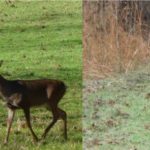
Tracking seasonal buck movement
As this article goes to press, the 2012-13 deer season is about three months in the rear view mirror. As they say, “It is time to re-load and re-mount.”
We should all use this seasonal lull to begin a personal assessment of what was learned from our recent trail camera efforts. Toward this end, hopefully you retained trail cam photo data in an organized and easily accessed format, allowing you the ability to review your seasonal trail cam photo collection at any time, as needed.
Also, I highly recommend using pen and paper during each active deer/trail camera season to make note of any and all interesting observations about buck movement and camera placement that are derived from your personal trail camera photo stream, as the photo data flows in throughout the season.
I know from experience that memories quickly fade over time, so trying to remember important observations made during a given deer season for future use is often a futile exercise. The result is usually less than desirable, so don’t just trust your memory when it comes to the valuable information and insights that are collected from your trail camera data from season-to-season: The amount of time and energy spent gathering the photos is just too great a price to pay to risk squandering what can be gained by keeping decent records.
I take this to an even higher level through the use of annual buck photo binders. As buck photo data rolls in across a season, using PowerPoint on my computer, I put together a photographic record of unique bucks by periodically compiling separate PowerPoint montages of photos, usually around six or more photos per page. A new montage is put together about once every week or so, and then saved with a file name denoting the time period of the photos.
Trail camera photos and photo compilations are data intensive, and usually result in very large and unwieldy high-megabyte file sizes. As a result, most raw PowerPoint files are impractical for attachment to emails from the standpoint of file size.
This is unfortunate, as most of us want to keep friends and hunting partners up to date on what we are seeing on our trail camera photos.
To overcome this problem, I save an additional copy of each PowerPoint photo montage in .PDF format, resulting in a much smaller file size that is easily e-mailed as an attachment.
To guard against loss of irreplaceable data, I keep my photo data on a portable hard drive, and then keep that hard drive backed up to a second master portable hard drive. Computers and hard drives can “crash,” so take precautions and use redundancy in your computer file storage.
I learned this lesson the hard way, so if you are not already safeguarding your files, please consider doing so in the future.
Regarding seasonal buck movement patterns, I have been tracking and reaffirming certain annual buck tendencies for several years now by way of trail camera surveillance.
The general pattern of the ebb and flow of annually repeating movement is remarkably repetitive, and replicates perfectly what recent deer research has shown.
Over the past six or more years, my ever-expanding data bank of trail cam buck photos has year after year shown three basic categories of bucks that are seen on my property. The three categories are resident bucks, range-shifter and expander bucks, and occasional visitor bucks.
My time frame of trail camera surveillance usually encompasses the rough time period from about August through February each year — sometimes less, sometimes more. That period of time includes the pre-rut, rut and post-rut phases of buck activity here in the Deep South.
During that period, I see bucks that are true residents that are observed off-and-on on my property from start to finish.
Then we have the range-shifters and range-expanders. This category of buck includes deer that are only seen during the preseason before completely vanishing as they shift their range totally off of my property, plus bucks that suddenly shift or expand their seasonal range onto my property from elsewhere during the rut.
And, finally, we see the occasional visitor classification of buck that resides somewhere else — often quite a distance away — but that, for whatever reason, suddenly takes off on a tour and may be seen on your photos or by eyeball just once or for just a day or so before vanishing.
Understanding how bucks move seasonally on your hunting property can be a key component for success.
I can’t really finish up this month’s article without briefly bringing back up the topic of using an iPad to assist in the evaluation of trail camera photos in the field. Having used an iPad in conjunction with my trail camera efforts for the first time this past deer season, I can attest how helpful and handy it actually was.
All that was required, beyond the basic iPad itself, was an adaptor cable and a memory card reader.
I found my iPad to be most valuable for quick field evaluation of photos while actually at a camera site. A decision could then be made on the spot whether to leave the camera in place, to reposition it for a better angle or to completely move it somewhere that might be more productive.
I only viewed the photos briefly at each camera site, not actually saving them to the iPad. This is because I have two designated memory cards for each trail camera, and each time a memory card is swapped and rotated, the cards with the latest new photos are always brought home so the photo data can be properly saved and backed up on my hard drives.
I am convinced that when it comes to trail camera data, less is not more. Take the time and go through the extra steps to maximize your trail camera surveillance results.




